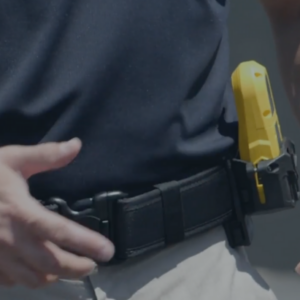BolaWrap: A More Humane Non-Lethal Option for Those with Mental Illness
The author, Nicholas Greco IV, President and Founder of C3 Education and Research, emphasizes the importance of considering safer options for law enforcement encounters with individuals, particularly those dealing with mental illness.

by Nicholas Greco, M.S., BCETS, CATSM, FAAETS
President, C3 Education and Research, Inc.
While there are several non-lethal options for agencies to choose from, are they the most appropriate option to use on an individual suffering from a mental health crisis? Let’s consider the history of psychiatric care in the United States prior to the first antipsychotic medication. The treatment options for patients were quite limited in institutions, wards, and state hospitals across the country.
Early psychiatric interventions
Prior to 1954, psychiatric medicine had a limited number of choices when it came to treating mental illness. Electro-convulsive therapy (ECT), insulin shock therapy, Metrazol shock therapy, strait jackets, and tying people down to the beds were the choices for treatment and restraint.
It was not until 1954, with the introduction of the first antipsychotic, Thorazine, that psychiatry had a reliable medication. These medications, known as typical antipsychotics or major tranquilizers were a breakthrough in the treatment of psychiatric illness. This was the beginning of psychopharmacology and a host of antipsychotic, antidepressant, antimanic, and anti-anxiety medications soon followed. Unfortunately, starting in 1955, these breakthrough medications would also help usher in what became known as deinstitutionalization.

Deinstitutionalization and unintended consequences
One of President Kennedy’s last acts in office was to sign the Community Mental Health Act of 1963. Patients would receive medications upon discharge and follow up with soon-to-be-built outpatient community mental health centers. States would save enormous amounts of money by reducing the number of inpatients while giving patients back their autonomy in a least restrictive setting.
The money the states saved would help fund building new community mental health centers. The states emptied out their institutions and asylums of 500,000 individuals over the years, but they also shut down these facilities without providing enough of the various community resources for those with mental illness.
Rise in mental health-related issues
While deinstitutionalization sounded wonderful on paper, the reality was an influx of people who, lacking supervision to take their medications, either forgot to do so or did not want to take their medications due to the nature of their illness.
With nowhere to go, they began to flood general medical hospitals seeking treatment, others were simply homeless, and still others began to be arrested and hauled off to jail. By 1984, the problem was evident that deinstitutionalization was a failure, but no one had the time, money, or a plan to solve it.
Increased demand for mental health services
Today, we have more people in need of mental health services, less inpatient facilities, way less community mental health centers, and a reliance on police officers to respond to those in crisis.
If deinstitutionalization was supposed to advance the field, it would have the opposite effect as Riker’s Island, L.A. County Jail, and Cook County Jail house the most psychiatrically ill persons. Think about that; we went from clearing out hospitals to putting people on the street and in jail. We have gone backwards in providing psychiatric care in this country.
As we mark the 70th anniversary of the introduction of the first psychiatric medication, I am reminded of the non-lethal options for capture and control of mentally ill individuals.

Non-Lethal Options and Use of Force in Modern Policing
While ECT is performed today under more controlled and humane conditions in a hospital than when it was first introduced, we are still subjecting an individual to electric shock, short-term memory loss, and some slight muscle pain.
If we can all agree that having a mental illness is not a crime, then using a conducted energy device (CED) on a subject with mental illness may very well seem like punishment.
Challenges with CEDs
CEDs have a place in modern law enforcement; however, the use of a CED to capture and control an individual with mental illness does not necessarily build rapport with the individual in crisis nor build trust with the community.
The individual suffering from mental illness is often scared, experiencing a distortion in their reality, and is not thinking rationally like you or me. This is not to say that a CED cannot or should not be used on a mentally ill person, but I ask: is there another option?

Introduction of BolaWrap as a Non-Lethal Alternative
BolaWrap seems to be that tool that the caped crusader would have on his utility belt. BolaWrap is a solution to consider having on your duty belt if you need to safely restrain a person in a mental health crisis who may be a danger to themselves or others, but also when using pain compliance techniques or higher use of force tools may not be needed.
This is a quick, safe, and effective method for helping to reduce the risk of the person being restrained, as well as the officer.
BolaWrap in Crisis Intervention
BolaWrap allows an officer to de-escalate and restrain from a safe distance without pain. Looking at this from the other side of the coin, if your son, daughter, spouse, mother, or father was suffering from a crisis, would you want them blinded by pepper spray, tased, or struck with a baton? Wouldn’t you want a less intrusive, less traumatic method used such as simply wrapping them with a cord?
This is also where the idea of decriminalizing mental illness comes into play – a non-violent way to control the situation while minimizing harm. BolaWrap allows safe capture and control from a distance without the traumatic aftereffects from other less lethal methods.
Benefits of BolaWrap in Law Enforcement
The BolaWrap remote restraint device operates by deploying a Kevlar cord with weighted ends to entangle a person’s limbs, thereby restricting their movement. BolaWrap provides law enforcement officers with a non-lethal means of immobilizing individuals who may be non-compliant or pose a threat.
When BolaWrap is deployed, a Kevlar cord wraps around one of two areas on the body: the lower legs or the upper body between wrists and elbows.
Unlike other methods, there is a reduced risk of injury both to the individual being restrained and the officers using the device. It does not rely on physical strikes or pain compliance techniques, reducing the likelihood of fractures, bruises, or other injuries.
The deployment of BolaWrap is often perceived as less confrontational than traditional physical force. This, in turn, can help de-escalate situations and reduce tension. BolaWrap provides officers with an additional tool to gain compliance from individuals without resorting to more aggressive measures.

Integration of BolaWrap in Crisis Intervention Training
In crisis intervention team (CIT) training, time, distance, and having more options are consistently discussed throughout a 40-hour training.
In addition, officer and citizen safety are paramount, and any tool that can be deployed safely both for the officer and for the individual in crisis, without any lingering trauma or shock after deployment, is worth considering.
Towards Safer Outcomes in Mental Health Encounters
Many law enforcement agencies are understandably cautious to adopt new technology, and I get that. But that is no reason not to consider this new non-lethal option with an open mind.
If we are to continue to make progress in non-lethal encounters between law enforcement and our community members, especially those suffering from mental illness, we need to prioritize safer outcomes through safer options.
Until next time, stay safe.

About the Author
Nicholas (Nick) Greco IV, M.S., B.C.E.T.S., C.A.T.S.M., F.A.A.E.T.S., is President and Founder of C3 Education and Research, Inc. Nick has over 25 years of experience training civilians and law enforcement.
He has directed, managed, and presented on over 700 training programs globally across several topics including depression, bipolar disorder, schizophrenia, verbal de-escalation techniques, post-traumatic stress disorder, burnout, and vicarious traumatization. Nick has authored over 325 book reviews and has authored or co-authored over 45 articles in psychiatry and psychology.
Nick is a subject matter expert for Police1/Lexipol and Calibre Press, as well as a CIT instructor for the Chicago Police Department, CIT Coordinator and Lead CIT Trainer for both the NAMI Kenosha CIT Program and the Lake County Sheriff’s CIT Program. Nick is a member of the International Law Enforcement Educators and Trainers Association (ILEETA), IACP, IPSA, LETOA, and CIT International, Co-founder of Protecting the Guardian, and a member of the Wellness support team for Survivors of Blue Suicide (SBS).






